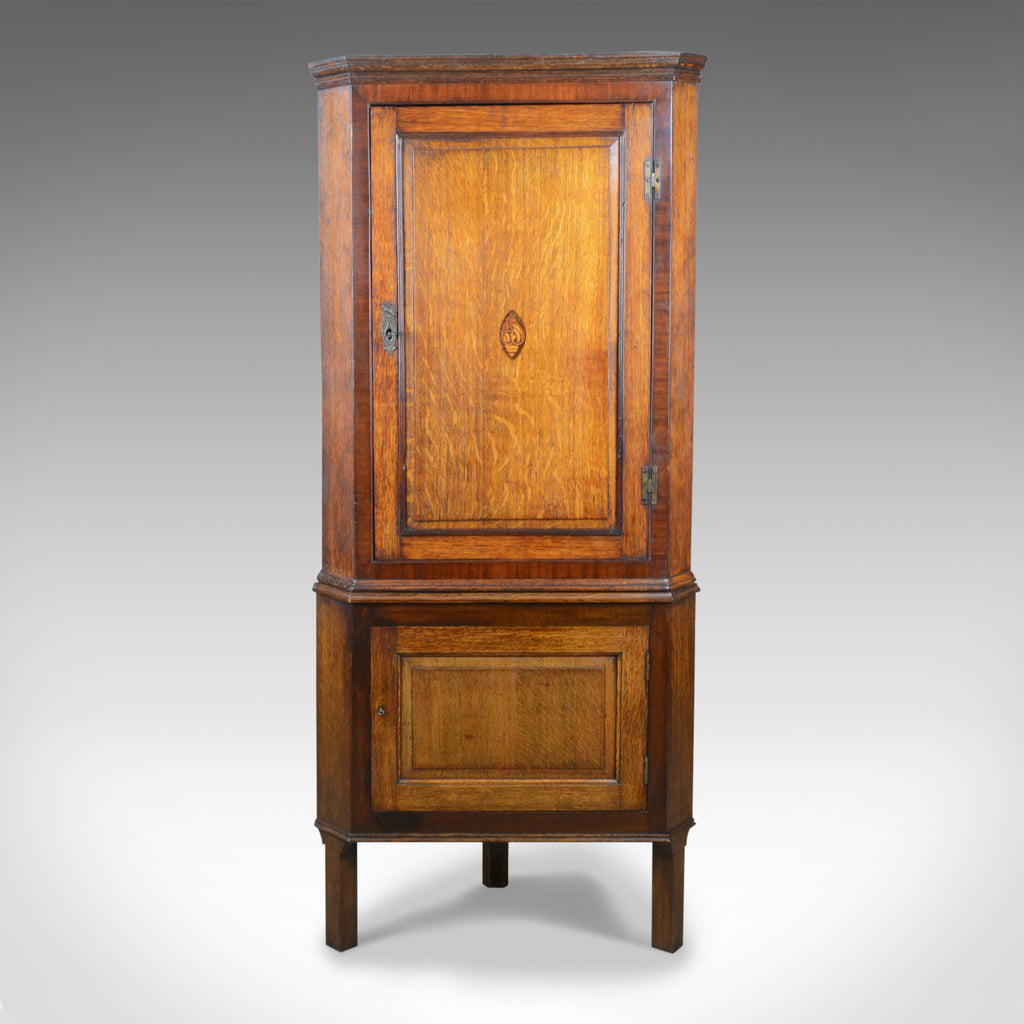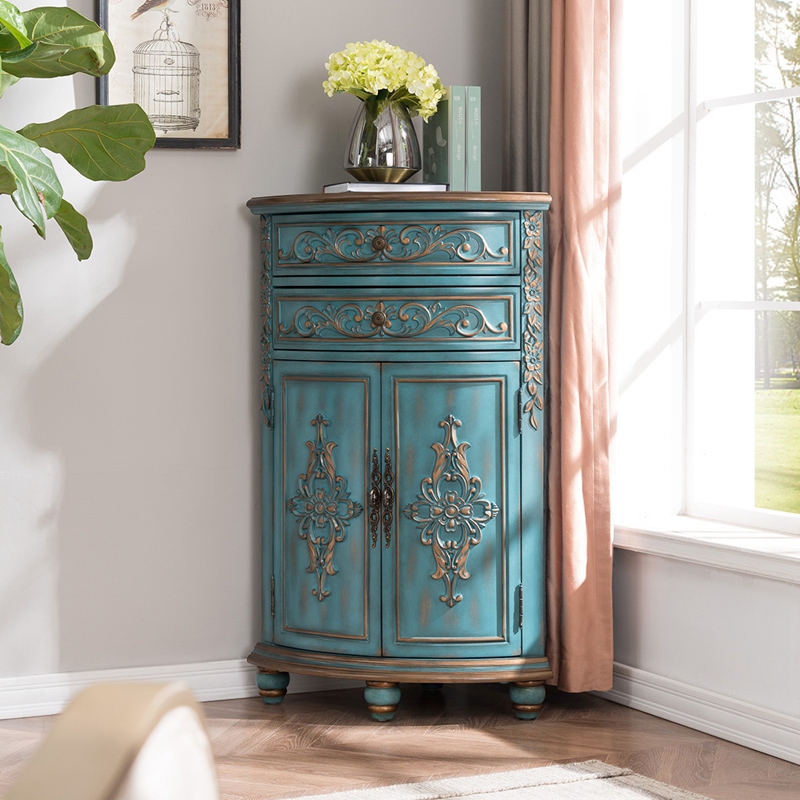History and Origins of Corner Cabinets: Corner Cabinet Antique Furniture

Corner cabinets, a staple in many homes, have a rich history spanning centuries. These versatile pieces of furniture, designed to maximize space and add visual appeal, have evolved significantly over time, reflecting changing styles, materials, and cultural preferences.
Early Forms and Influences
The origins of corner cabinets can be traced back to ancient civilizations, where space optimization was crucial. In ancient Egypt, corner cupboards were used for storing food and household items. The Romans also utilized corner cabinets, often incorporating them into their elaborate villas. However, it was during the Middle Ages that corner cabinets truly began to emerge as a distinct furniture type.
- Medieval Era: During this period, corner cabinets were often crafted from sturdy oak or pine and featured simple, functional designs. These cabinets were typically used for storing food, linens, and other household necessities. They often featured a single door or a pair of doors, and their interiors were often left plain or decorated with simple carvings.
- Renaissance Period: The Renaissance marked a shift toward more elaborate and decorative furniture designs. Corner cabinets of this era often incorporated intricate carvings, decorative moldings, and ornate hardware. They were typically made from walnut, cherry, or oak, and they were often painted in vibrant colors. Some notable examples include the corner cabinets found in the Palazzo Pitti in Florence, Italy, which feature exquisite carvings and intricate inlays.
- Baroque and Rococo Periods: These periods witnessed a further evolution of corner cabinet design, with an emphasis on grandeur and opulence. Baroque corner cabinets often featured elaborate carvings, gilded surfaces, and dramatic curves. Rococo corner cabinets, on the other hand, were characterized by their delicate, whimsical designs, featuring flowing curves, asymmetrical shapes, and floral motifs.
Materials and Techniques
The materials and techniques used in corner cabinet construction have varied significantly throughout history.
- Early Forms: Early corner cabinets were often constructed from simple, readily available materials such as oak, pine, or elm. Simple joinery techniques were employed, with mortise-and-tenon joints being a common method for assembling the cabinet’s frame.
- Renaissance and Later: As craftsmanship advanced, more sophisticated materials and techniques were introduced. Walnut, cherry, and mahogany became popular choices for corner cabinet construction, and techniques such as veneering and marquetry were used to create intricate and decorative surfaces.
- Antique Era: During the antique era, corner cabinets were often crafted from high-quality hardwoods, such as mahogany, cherry, and walnut. The cabinetmakers of this period were skilled artisans, and they employed advanced techniques such as dovetail joinery, hand-cut moldings, and intricate carvings to create truly exquisite pieces.
Notable Examples, Corner cabinet antique furniture
Throughout history, numerous corner cabinets have stood out for their craftsmanship, design, and historical significance.
- The “Corner Cupboard” from the Château de Fontainebleau (France): This 16th-century cabinet, crafted from walnut and oak, features intricate carvings and a bold, Renaissance-inspired design. It exemplifies the craftsmanship and artistry of the French Renaissance.
- The “Corner Cabinet” from the Victoria and Albert Museum (London): This 18th-century cabinet, made from mahogany and inlaid with ebony and ivory, showcases the refined elegance of the Georgian period. Its intricate marquetry work and graceful curves are a testament to the skills of English cabinetmakers.
- The “Corner Cabinet” from the Metropolitan Museum of Art (New York): This 19th-century cabinet, crafted from American walnut and featuring elaborate carvings, exemplifies the craftsmanship of the American Empire style. Its grandeur and attention to detail make it a true masterpiece of American furniture making.
Styles and Characteristics of Antique Corner Cabinets
:max_bytes(150000):strip_icc()/SECornerBarCabinet-6a92557969dd4820825ce1d6c1e3c357.jpeg)
Antique corner cabinets, with their intricate designs and timeless appeal, are a testament to the craftsmanship of bygone eras. They offer a glimpse into the diverse aesthetic trends that shaped interior design throughout history. Each style, characterized by its unique features and decorative elements, reflects the cultural and artistic influences of its time.
Styles of Antique Corner Cabinets
Antique corner cabinets are classified into various styles, each embodying a distinct artistic movement and design philosophy.
- Victorian (1837-1901): This era is known for its opulent and elaborate designs. Victorian corner cabinets often feature intricate carvings, ornate moldings, and rich, dark wood finishes. They frequently incorporate elements like stained glass, mirrored panels, and elaborate hardware.
- Queen Anne (1702-1714): Characterized by its graceful curves and delicate ornamentation, Queen Anne corner cabinets showcase a more refined aesthetic. They often feature cabriole legs, shell carvings, and simple, elegant details.
- Arts & Crafts (1880-1920): This movement emphasized simplicity, functionality, and natural materials. Arts & Crafts corner cabinets often feature clean lines, handcrafted details, and the use of woods like oak and cherry. They may incorporate elements of Arts & Crafts design, such as hammered metal hardware or hand-painted motifs.
- Art Deco (1920-1939): Art Deco corner cabinets exhibit a geometric aesthetic with bold, symmetrical forms and a focus on geometric patterns. They often feature luxurious materials like exotic woods, metal accents, and colorful inlays.
- Mid-Century Modern (1930-1965): Mid-Century Modern corner cabinets emphasize functionality and clean lines. They often feature minimalist designs, sleek materials like teak or walnut, and innovative construction techniques.
Distinctive Features and Decorative Elements
Each style of antique corner cabinet is characterized by its unique features and decorative elements:
- Victorian: Intricate carvings, ornate moldings, dark wood finishes, stained glass, mirrored panels, elaborate hardware.
- Queen Anne: Cabriole legs, shell carvings, simple, elegant details.
- Arts & Crafts: Clean lines, handcrafted details, oak and cherry wood, hammered metal hardware, hand-painted motifs.
- Art Deco: Geometric forms, symmetrical patterns, exotic woods, metal accents, colorful inlays.
- Mid-Century Modern: Minimalist designs, sleek materials like teak or walnut, innovative construction techniques.
Examples of Antique Corner Cabinets
| Style | Period | Materials | Notable Features |
|---|---|---|---|
| Victorian | 1837-1901 | Mahogany, walnut, cherry | Intricate carvings, ornate moldings, stained glass panels |
| Queen Anne | 1702-1714 | Walnut, oak, mahogany | Cabriole legs, shell carvings, simple, elegant details |
| Arts & Crafts | 1880-1920 | Oak, cherry, maple | Handcrafted details, hammered metal hardware, natural finishes |
| Art Deco | 1920-1939 | Exotic woods, metal accents, glass | Geometric forms, bold colors, inlays |
| Mid-Century Modern | 1930-1965 | Teak, walnut, plywood | Clean lines, minimalist designs, innovative construction |
Practicality and Uses of Antique Corner Cabinets

Antique corner cabinets were not merely decorative elements; they were essential pieces of furniture designed for both functionality and aesthetic appeal. Their unique shape and design allowed them to maximize space utilization in historical homes, offering practical storage solutions for various items.
Maximizing Space Utilization
The ingenious design of corner cabinets allowed them to efficiently utilize often-overlooked spaces in rooms. Their triangular or curved shape enabled them to fit snugly into corners, maximizing floor space and minimizing wasted areas. This was particularly beneficial in smaller homes where space was at a premium.
Storage Options and Features
Corner cabinets offered a variety of storage options, catering to different needs and preferences. Here are some examples:
- Shelves: Many corner cabinets featured adjustable shelves, providing flexibility in storing items of different sizes. This allowed for efficient organization and easy access to contents.
- Drawers: Some corner cabinets incorporated drawers, providing additional storage space for smaller items that needed to be kept out of sight. These drawers were often fitted with decorative pulls or handles, adding to the aesthetic appeal of the cabinet.
- Cabinets with Doors: Corner cabinets with doors offered privacy and protection for valuable items. The doors were often crafted from intricate wood carvings or adorned with decorative hardware, adding to the overall charm of the piece.
Incorporation into Room Layouts
Corner cabinets were versatile pieces of furniture that could be incorporated into various room layouts.
- Dining Rooms: Corner cabinets were often used in dining rooms to store china, silverware, and linens. Their placement in a corner allowed them to be discreet yet accessible.
- Living Rooms: Corner cabinets could be used in living rooms to display decorative items, books, or other personal belongings. They could also serve as a focal point in the room, adding visual interest to the space.
- Bedrooms: Corner cabinets were often used in bedrooms for storing clothing, accessories, and other personal items. They could be placed in a corner of the room to maximize floor space and provide a convenient storage solution.
Corner cabinet antique furniture – Corner cabinets are a classic choice for antique furniture, offering both practicality and a touch of vintage charm. They’re often seen as a statement piece, especially when crafted from intricate wood and adorned with intricate carvings. For a truly elegant addition to your home, consider an antique Duncan Phyfe china cabinet , renowned for its exquisite craftsmanship and timeless design.
These cabinets, often with glass doors, can be a beautiful way to showcase your finest china or other treasured possessions. Corner cabinets, whether traditional or contemporary, are a timeless choice that can add a touch of history and sophistication to any space.
Corner cabinets, particularly those with an antique air, can really add a touch of class to a room. They’re perfect for showcasing those cherished porcelain figures or family heirlooms. If you’re looking for something to elevate your dining room, consider a set of dining room furniture with china cabinet – a great way to display your finest china and create a focal point.
Corner cabinets, with their compact size and timeless appeal, can be a lovely addition to any room, even if it’s just to store those odd bits and bobs that never seem to find a home.
